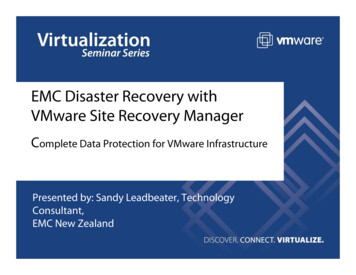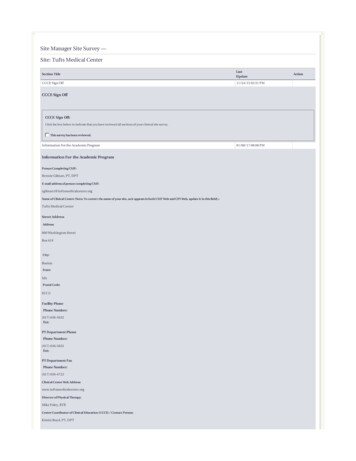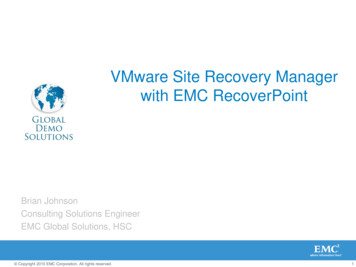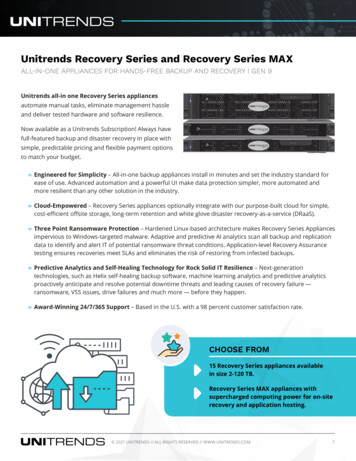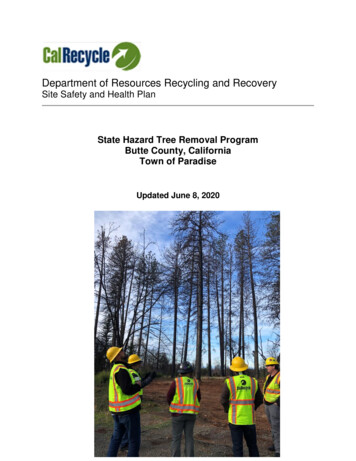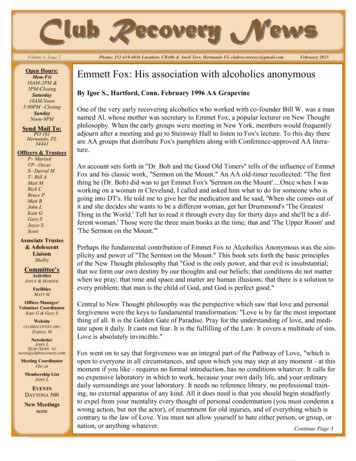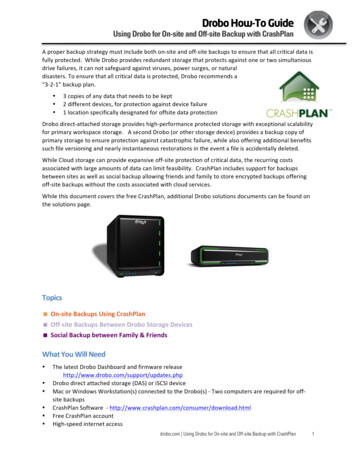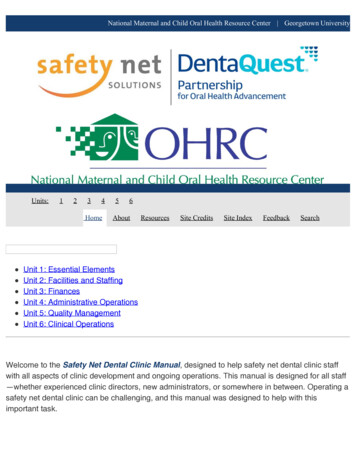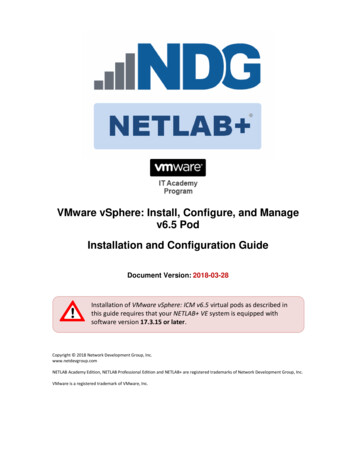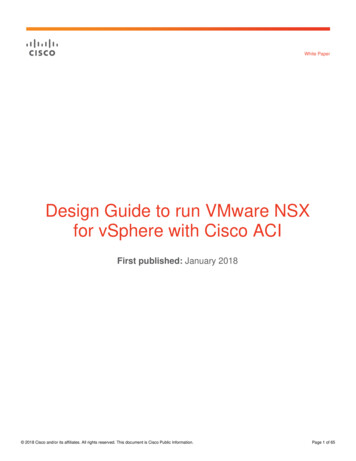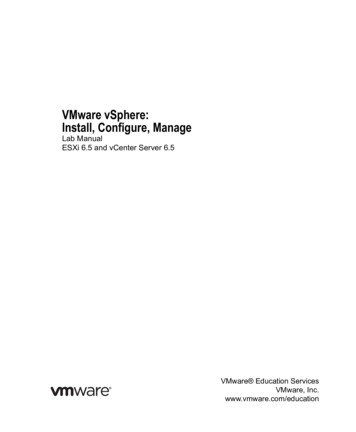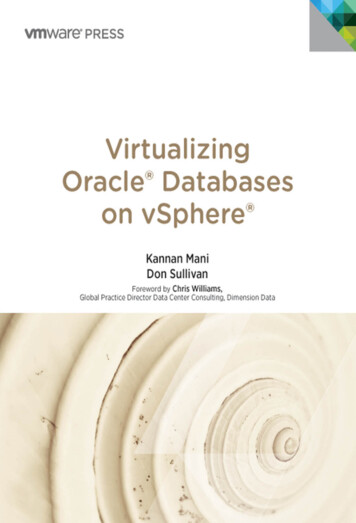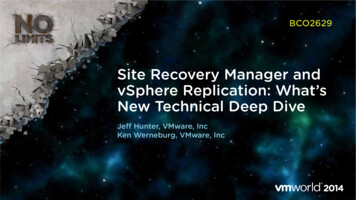
Transcription
BCO2629Site Recovery Manager andvSphere Replication: What’sNew Technical Deep DiveJeff Hunter, VMware, IncKen Werneburg, VMware, Inc
Disclaimer This presentation may contain product features that are currently under development. This overview of new technology represents no commitment from VMware to deliver thesefeatures in any generally available product. Features are subject to change, and must not be included in contracts, purchase orders, orsales agreements of any kind. Technical feasibility and market demand will affect final delivery. Pricing and packaging for any new technologies or features discussed or presented have notbeen determined.CONFIDENTIAL2
Agenda for Today1Site Recovery Manager quick recap2What’s New with SRM 5.83vSphere Replication (VR) Recap4VR Use Cases5What’s New with VR6Your turn to make noise on the microphoneCONFIDENTIAL3
The Software-Defined Data CenterExpand virtualcompute to allapplicationsVirtualize thenetwork for speedand efficiencyTransform storageby aligning it withapp demandsManagementtools give wayto automationCONFIDENTIAL4
The Software-Defined Data CenterTransform storageby aligning it withapp demandsCONFIDENTIAL5
Software-Defined Storage and AvailabilityBringing the Efficient Operational Model of Virtualization to StorageCommon policybased managementVM centric dataservicesAPIPolicy-driven Control PlaneAPIVirtual Data ServicesData ProtectionCloud DRThird-partyControl PlaneLocalAvailabilityThird-partyData ServicesVirtual Data PlaneAbstraction andpooling ofinfrastructureHypervisor-convergedStorage poolSAN/NAS Poolx86 ServersSAN / NASObject Storage PoolCloud Object StorageCONFIDENTIAL6
Availability TimelineSRM 5.8 ABR2014 SRM 5.5 ABRSRM 5.1 ABRSRM 5.0 ABRSRM 4.x ABRSRM 1.x ABRVR/SRM & SVR 5.8VR/SRM & SVR 5.52008VR/SRM & SVR 5.1VR 5.0 (SRM Only)CONFIDENTIAL7
Site Recovery Manager 5.8
Terminology Acronyms and terms we will be using– SRM (Site Recovery Manager)– ABR (Array Based Replication)– VR (vSphere Replication)– VRMS (vSphere Replication Management Server)– VRS (vSphere Replication Server)A1– “SVR” (Standalone vSphere Replication i.e. NO SRM involved)CONFIDENTIAL9
Slide 9A1Do we need SVR? Lots of acronyms for the audience to keep track of already.Author, 8/9/2014
vCenter Site Recovery Manager What is vCenter Site Recovery Manager (SRM)?Production SitevCenter ServerSite RecoveryManagerRecovery SitevSphereReplicationvCenter ServerSite RecoveryManager– SRM is the industry-leading disaster recoveryautomation solution for vSphere environments What are the key features?– Centralized recovery plans for thousands of VMsvSpherevSphere– Non-disruptive recovery testing– Automated DR workflows– Integrated with the VMware product stack What are the key benefits?ServersArray-basedreplicationServers– Lowers the cost of DR management by 50% or more– Eliminates complexity and risk of manual processes– Enables fast and highly predictable RTOs– Provides policy-driven DR control for any virtualized app* Disaster AvoidanceCONFIDENTIAL10
Typical Uses Cases for SRMDisaster Recovery Least frequent but mostcritical use case Ensure fastest RTO Avoid 145,000 per hourof downtime (Forrester)Disaster Avoidance Proactive, controlledworkflow Ensures app-consistencyand zero data lossPlanned Migration Frequent on-ramp usecase for SRM Enables data centermaintenance and globalload balancingCONFIDENTIAL11
Recovery WorkflowsFailover Automation User defined recovery plan Minimize errorsNon-disruptive Failover Testing Isolated test environment Increase confidence in DR processPlanned Migration Zero data loss Operational migrationFailback Automation Re-protect VM’s, migrate backCONFIDENTIAL12
What’s New in SRM 5.8
What’s New in Site Recovery Manager 5.8DR for the SDDCEnhanced ScalabilitySimplified Operations Self-service, policy-basedprotection – vCAC integrationthrough new vCO plugin 5x scale of protection – up to5,000 protected VMs pervCenter Server* Converged UI with vSphere –vSphere Web Client plugin Software-defined storage forDR – Virtual SAN integrationthrough vSphere Replication 2x scale of recovery –concurrent recovery of up to2,000 VMs per vCenterServer* Performance enhancement –storage stack improvementsreduces RTO Simplified IP addressmanagement – rule basedcustomization at the subnetlevel Faster installation –embeddeddatabase option (vPostgres)* Scale supported with array-based replicationCONFIDENTIAL14
Self-Service, Policy-Based DR Protection for Apps –And Other Workflows!Architecture SRM using array-based replication vCAC management across two sites Integration via vCO plugin for SRM New APIs exposed for PowerCLIintegrationProduction SiteCapabilitiesBenefits Self-service DR provisioning using vCACblueprints DR control delivered as a service to Automated protection mapping accordingto pre-defined tiers Quicker time to market for appsapp tenants Reduced complexity forinfrastructure adminsRecovery SitevCloud Automation CenterSite Recovery ManagerSite Recovery l StorageExternal Storage(1) Agents for SQL Server, Exchange and SharePointCONFIDENTIAL15
vCAC and SRM Workflow Load SRM plugin package into VCO Run workflow to attach SRM postprovisioning to a vCAC Catalog Item– Can do this against a ‘template’ CI Now when provisioning that CI, SRM priority and custom properties (callouts, etc.) will beprompted After deploy the workflow carries on:– Finds protection groups for the target datastore– Adds the VM to the protection group and associated recovery plansCONFIDENTIAL16
vCAC IntegrationSRM protectionexposedthrough vCACPortalCONFIDENTIAL17
Runs a Standard VCO Workflow after ProvisioningCONFIDENTIAL18
Not Just for vCAC Though The VCO plugin for SRM offers many other workflowsas well:– Create protection groups and add VMs– Find protection groups by datastore– Add protection to unprotected VMs in a replicateddatastore– and almost anything else the SRM API exposes cannow be accessed through the VCO plugin.CONFIDENTIAL19
Enhanced Scalability to Enable Large Enterprise Use CasesSRM 5.5SRM 5.8Protection1,500 VMs5,000 VMsConcurrentRecovery1,000 VMs2,000 VMsCONFIDENTIAL20
Performance ImprovementsCONFIDENTIAL21
CONFIDENTIAL22
Up to75%fasterRTOJust trust me there are lots ofperformance improvements
VMware Performance and Scale Testing 250 Protection Groups 2000 VMs with IP Customization ONTotal TimeStorage TimeOld Method29 h17 h 15 mNew Method13 h 53 m4 h 13 mCONFIDENTIAL24
SRM Is Now Even Simpler to Deploy and ManageConverged UI with vSphereNew SRM plugin for the vSphere Web Client andenhanced workflowsSimplified IP address managementRule-based management at the subnet levelFaster installationOptional embedded vPostgres DBCONFIDENTIAL25
New SRM Plugin for the Web InterfaceCONFIDENTIAL26
New SRM Plugin for the Web InterfaceCONFIDENTIAL27
New SRM Plugin for the Web InterfaceCONFIDENTIAL28
No It’s Not Really the MUICONFIDENTIAL29
No It’s Not Really the MUICONFIDENTIAL30
No It’s Not Really the MUICONFIDENTIAL31
No It’s Not Really the MUICONFIDENTIAL32
IP Subnet MappingDr-ip-customizer --cfg .\config\vmware-dr.xml -oc:\example.csv --cmd generate --vc vcenter-recoveryDr-ip-customizer --cfg .\config\vmware-dr.xml --csvc:\example.csv --cmd apply --vc vcenter-recoveryCONFIDENTIAL33
IP Subnet MappingDr-ip-customizer --cfg .\config\vmware-dr.xml -oc:\example.csv --cmd generate --vc vcenter-recoveryDr-ip-customizer --cfg .\config\vmware-dr.xml --csvc:\example.csv --cmd apply --vc vcenter-recoveryCONFIDENTIAL34
IP Subnet MappingDr-ip-customizer --cfg .\config\vmware-dr.xml -oc:\example.csv --cmd generate --vc vcenter-recoveryDr-ip-customizer --cfg .\config\vmware-dr.xml --csvc:\example.csv --cmd apply --vc vcenter-recoveryCONFIDENTIAL35
IP Subnet MappingCONFIDENTIAL36
IP Subnet MappingCONFIDENTIAL37
VSAN VR and Site Recovery ManagervCenterC tServer Virtual SAN is compatible with:recovery siteprotected sitevCenterC tServerVR/SRMVR/SRM– vSphere Replication– SPBM configured as part of replication– vCenter Site Recovery ManagervSpherevSphere Virtual SAN– SRM configuration based on VR replicationVMFS vSphere Replication & vCenter SRMSSD HarddisksSSDHarddisksSSDHarddisks– Asynchronous replication – 15 minute RPO– VM-Centric based protection– Provide automated DR operation & orchestration– Automated failover – execution of user defined plans– Automated failback – reverser original recovery planreplication– Planned migration – ensure zero data loss– Point-in-Time Recovery – multiple recovery points– Non-disruptive test – automate test on isolated networkCONFIDENTIAL38
SRM Replication OptionsStorage-based ReplicationMulti-tier App SRM can utilize BOTH array based ANDvSphere ReplicationLUN 1WebAppHubLUN 2DB SRM will “see” existing standalone vSphereReplication protected VMsvSphere ReplicationMulti-tier AppWeb SRM can install vSphere Replication fromscratch if neededAppDBCONFIDENTIAL39
vSphere Replication 5.8
vSphere Replication Per-VM host-based replication integrated with vSphere platform Included with vSphere Essentials Plus and higher editionsLocation ALocation l SANCONFIDENTIAL41
vSphere Replication Easy virtual appliance deployment Integration with vSphere Web Client Protect any VM regardless of OS and apps Flexible recovery point objective (RPO) policiesReplicate workloads tovCenter Server andvCloud Air Quick recovery for individual VMs Replication engine for Site Recovery Manager (SRM) Compatible with SAN, NAS, local, and VSAN storageCONFIDENTIAL42
vSphere Replication Use Cases Data protection and disaster recovery Data center migrationDataCenter Replication engine for SRM Stand alone replication Within the same site Across sites - vCenter Server and vCloud AirDataCentervCloudAirCONFIDENTIAL43
Replication to vCenter Server and vCloud AirCONFIDENTIAL44
Replication to vCloud AirCONFIDENTIAL45
vSphere Replication ComponentsvCenter ServervSphere Web ClientAPPDATAOSAPPDATAOSManagementand VRSvSphere ReplicationManagement Server(VRMS)vSphere Replication Agent(VRA) built into vSpherevSphere ReplicationServer (VRS)CONFIDENTIAL46
vSphere Replication Limitations VM must be powered on to replicate RPO 15 minutes to 24 hours Up to 10 appliances per vCenter Server– One VRMS (required), up to nine VRS (optional) Supported max of 500 replicated VMs per vCenter Server VMs protected by vSphere FT not supported Physical Raw Device Mapping (RDM) not supportedCONFIDENTIAL47
vSphere Replication Disk ConsistencyAPPAPPDATADATAOSWithin a VM:YesSource VMDKsOSAcross VMs:NoNoYesYesNoTarget VMDKsCONFIDENTIAL48
vSphere Replication Application ConsistencyCONFIDENTIAL49
vSphere Replication ReportingCONFIDENTIAL50
vSphere Replication ReportingCONFIDENTIAL51
vSphere Replication ReportingCONFIDENTIAL52
vSphere Replication MPIT Recovery Multiple point in time (MPIT) recovery - up to 24 recovery points– Examples: 4 recovery points, last 6 days 3 recovery points, last 5 daysCONFIDENTIAL53
vSphere Replication MPIT Recovery Recovered as VM with snapshots– vSphere Replication recovers latest replica– Use Snapshot Manager to roll back to recovery pointCONFIDENTIAL54
vSphere Replication Recommendations Set RPO to longest acceptable value– 15-minute RPOs: Just because you can, does not mean you should Leave VSS quiescing disabled unless really necessary– Majority of apps recover well from crash-consistent copy Configure minimum acceptable number of MPIT recovery points– Fewer recovery points faster recovery time, less storage consumptionCONFIDENTIAL55
vSphere Replication Resources vSphere Replication Calculator Documentation Overview white paper Frequently Asked Questions Capacity Planning Appliance (Fling) BlogsCONFIDENTIAL56
What Have We Covered? Site Recovery Manager 5.8 vSphere Replication– vCAC integration via VC Orchestrator– Recap– New web based user interface– Use cases and architecture– Scale and Performance improvement– Reporting– IP Subnet Mapping– Recommendations– vPostgres Database– Resources– VSAN IntegrationCONFIDENTIAL57
Software-Defined Storage and AvailabilityBringing the Efficient Operational Model of Virtualization to StorageCommon policybased managementVM centric dataservicesAPIPolicy-driven Control PlaneAPIVirtual Data ServicesData ProtectionCloud DRThird-partyControl PlaneLocalAvailabilityThird-partyData ServicesVirtual Data PlaneAbstraction andpooling ofinfrastructureHypervisor-convergedStorage poolSAN/NAS Poolx86 ServersSAN / NASObject Storage PoolCloud Object StorageCONFIDENTIAL58
CONFIDENTIAL59
Supplemental Slides
vSphere Replication Simplifies DR for vSphere What is vSphere Replication (VR)?Site A (Primary)– VR is VMware’s proprietary technology forhypervisor-based replication of vSpherevirtual machinesvSphere What are the key features?– Asynchronous replication with customizable RPOvSphereReplication– VM-centric management, storage-agnostic– Multiple point-in-time recovery (MPIT)Site B (Recovery) What are the key benefits?– Simplifies replication of virtual machinesvSphere– Eliminates storage hardware lock-in– Integrated with the VMware product stack– Included with vSphere at no additional costCONFIDENTIAL61
Workloads NOT Suitable for vSphere Replication?Shared inter-site components AD, DNS, LDAP Typically shared across sitesvCenter Server Official solution, “Heartbeat” Could be done, unsupportedHigh Churn & VSS Usually aggressive RPO VSS Quiescence time overheadInter-VM write order fidelity Array Based Consistency GroupsZero RPO VR Range is 15min-24hrs Use array replication 15minUnsupported Check release notes! pRDMs, multi-writer VMDK’s etc.CONFIDENTIAL62
What Use Is vSphere Replication without SRM?Disaster Recovery for smallerenvironmentsESXiVRANFCIndividual VM recoveryLocal & Intra site replicationimplementationsVR ApplianceStorageVMDK3(VMDK3)Location migration requirementsCONFIDENTIAL63
Ok So What Do We Miss out on if We Decide Not to Use SRM?Failover / Migration WorkflowAutomationNon-disruptive Failover TestingBuilt-in Reporting / Alerting &CustomizationCustomizable OrchestrationCONFIDENTIAL64
vSphere Replication Appliance Increase - Advantage for ROBOESXiVR AppliancevCenter ServerBranch 1VRANFCVR MDK2)NFCESXiVRAVMDK1NFCStorage(VMDK1)Branch 2StorageVR ApplianceStorageVMDK3(VMDK3)CONFIDENTIAL65
Multi Point-In-Time Recovery (MPIT)Protected VMESXiCurrent ReplicaN-1VRAN-2N-3Retention of multiple points in time allows reversion to earlier known good statesCONFIDENTIAL66
MPIT ConfigurationRetention policy is specified during configuration of replicationCONFIDENTIAL67
MPIT Presented as VM Snapshots after FailoverUse the snapshot manager to revert to earlier pointsCONFIDENTIAL68
MPIT Details Retention “slots” differ from “replication instances” Example:– RPO 4 Hours– Retention Policy 3 instances for past 1 day(s)instance expiresinstances23:573:44latest ost recent complete instance is *always* preserved.Most recent *might* be the second instance in the slot.(Ensures you can always failover to the most recent copy)CONFIDENTIAL69
MPIT Details Example:– RPO 4 Hours– Retention Policy 3 instances for past 1 day(s)instance expiresinstances3:4412:3816:34latest instance20:280:28timeslots0:008:0016:000:00The oldest instance in any given retention slot is preserved,as is the most recent replicationCONFIDENTIAL70
vSphere Replication Included with vSphere Essentials Plus and higher Per VM, async replication Replication at the VMDK level Fully integrated with vCenter / ESXi 5.x Use cases with AND without SRMCONFIDENTIAL71
vSphere Replication Appliance Single Appliance to download– Same appliance used in SRM and non-SRM deployments– Initial instance performs two roles Role 1 - vSphere Replication Management Server (VRMS)– Configuration management– Only one appliance per site performs role– Warning if attempt to configure 1 per site Role 2 - vSphere Replication Server (VRS)– Manages replica instances– One or more per site (up to 10 max)CONFIDENTIAL72
Simple DeploymentDeploy and configureVR componentsPair componentswith vCenterConfigure VM forreplication** Will need to define RPO, Target Datastore, Target Folder or Resource poolCONFIDENTIAL73
Configuring vSphere ReplicationVR replication is configuredper VM in vCenterSelectable RPO from 15 minup to 24 hoursSelectable destinationdatastore (per virtual disk)CONFIDENTIAL74
Four Steps for Full RecoveryRight-click, select “Recover”Select a target folderSelect a target resourceClick FinishWill validate your choices as you goCONFIDENTIAL75
vSphere Replication Use Cases
vSphere Replication Standalone Local site replica– Singe site copy– Works with single vCenter Replication between sites– Each site own vCenter– Replicate in either direction Remote office / Branch office– Support for single vCenter– Support for single VR applianceCONFIDENTIAL77
Local Site ReplicavCenter ServerVR CStorage(VMDK1)CONFIDENTIAL78
Replication Across SitesVR ApplianceESXiESXiVRAESXiVRANFCVR AppliancevCenter ServerESXiVRANFCStorageStorageESXiVRANFCvCenter )CONFIDENTIAL79
Remote Office Branch Office (ROBO)ESXiVR ApplianceESXivCenter ServerESXiBranch DK1NFCStorage(VMDK1)Branch 2Storage(VMDK2)StorageVMDK3(VMDK3)CONFIDENTIAL80
Why Is vSphere Replication Not Using All Available Bandwidth?Built for “Full” host scheduling VM replication optimized per VMDK Current implementation scales effectively, many VMs, many VMDKs Not ideal for single high churn use case, stay tunedCONFIDENTIAL81
Thank You
Fill out a surveyEvery completed survey is enteredinto a drawing for a 25 VMwarecompany store gift certificate
BCO2629Site Recovery Manager andvSphere Replication: What’sNew Technical Deep DiveJeff Hunter, VMware, IncKen Werneburg, VMware, Inc
Aug 09, 2014 · vSphere Replication SRM will “see” existing standalone vSphere Replication protected VMs SRM can install vSphere Replication from scratch if needed Hub LUN 2 Web Multi-tier App DB App vSphere Replication Storage-based
